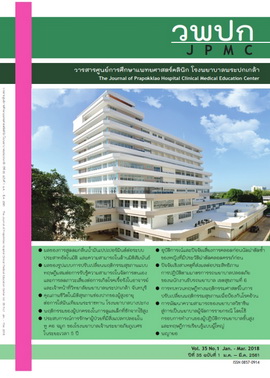Foreign bodies in ear nose and throat in Chao Phya Abhaibhubejhr hospital in 5 years
Main Article Content
Abstract
Background: Foreign bodies in ear nose and throat are the frequent problems, especially in children. In this study, I reviewed and analyzed the organs and types of foreign bodies
Objective: Report experience and result of treatment of patients who had foreign bodies in ear nose throat (esophagus or trachea) in Chaophya Abaibubejhr Hospital over 5 years.
Materials and methods: Retrospective study by collecting data of patients who were diagnosed with foreign bodies in ear nose or throat and given treatment by a doctor, especially otolaryngologists, in Chaophya Abhaibhubejhr Hospital between 1 January 2011 and 31 December 2015.
Results: The study included 1,087 patients between the ages of 1 year and 8 months to 72 years. There were 604 children (55.57%), and 483 adults (age>15 years) (44.43%). Most foreign bodies in children in ears were plastic beads, followed by rubber, seeds, stones, insects, modeling clay, etc. Foreign bodies found in the throat were fish bone, and in the nose were cotton, in the esophagus were coins and in the trachea were seed. Most foreign bodies in ears for adults were insects; throat were fish bone, nose were insects and esophagus were bone (chicken, duck, pig). The most common organ in which was foreign body was the ear (68.59%) in children and throat (47.00%) in adults.
Conclusion: Foreign bodies in ear nose and throat were varied in children and adults. Treatment of these patients in Chaophya Abhaibhubejhr Hospital was safe and had good results.
Keywords: foreign bodies; foreign bodies in ear nose and throat; otolaryngologist; Chaophya Abhaibhubejhr Hospital
Article Details
References
2. Lin E, Fink AS. Endoscopy and endoscopic intervention. In: Zinner MJ, Ashley SW, editor. Maingot’s Abdominal Operations. 11th ed. New York: McGraw-Hill; 2007. p35-68.
3. Eisen GM, Baron TH, Dominitz JA, Faigel DO, Goldstein JL, Johanson JF, et al. Guideline for the management of ingested foreign bodies. Gastrointest Endosc 2002; 55:802-6.
4. Park JH, Park CH, Lee SJ, Lee WS, Joo YE, Kim HS, et al. Review of 209 cases of foreign bodies in the upper gastrointestinal tract and clinical factors for successful endoscopic removal. Korean J Gastroenterol 2004; 43: 226-33.
5. Mukherjee A, Haldar D, Dutta S, Dutta M, Saha J, Sinha R. Ear, nose and throat foreign bodies in children: a search for socio-demographic correlates. Int J Pediatr Otorhinolaryngol 2011;75:510-2.
6. Mangussi-Gomes J, Andrade JS, Matos RC, Kosugi EM, Penido Nde O. ENT foreign bodies: profile of the cases seen at a tertiary hospital emergency care unit. Braz J Otorhinolaryngol 2013; 79: 699-703.
7. Sittitrai P, Pattarasakulchai T, Tapatiwong H. Esophageal foreign bodies. J Med Assoc Thai 2000; 83: 1514-8.
8. Niramis R, Watanatittan S, Anuntkosol M, Rattanasuwan T, Buranakitjaroen V. Retained foreign body in alimentary tract in children. Thai J Surg 2004; 21: 47-54.
9. Opasanon S, Akaraviputh T, Methasate A, Sirikun J, Laohapensang M. Endoscopic management of foreign body in the upper gastrointestinal tract: a tertiary care center experience. J Med Assoc Thai 2009; 92: 17-21.
10. Ashraf O. Foreign body in the esophagus: a review. Sao Paulo Med J 2006; 124: 346-9.
11. Khan MA, Hameed A, Choudhry AJ. Management of foreign bodies in the esophagus. J Coll Physicians Surg Pak 2004; 14: 218-20.
12. Khurana AK, Saraya A, Jain N, AmanV, Sen S. Management of foreign bodies of the upper gastrointestinal trac. Trop Gastroenterol 1998; 19: 32-3.
13. Nijhawan S, Shimpi L, Mathur A, Mathur V, Roop Rai R. Management of ingested foreign bodies in upper gastrointestinal tract: report on 170 patients. Indian J Gastroenterol 2003; 22: 46-8.
14. Nandi P, Ong GB. Foreign body in the oesophagus review of 2394 cases. Br J Surg 1978; 65: 5-9.
15. Little DC, Shah SR, St Peter SD, Calkins CM, Morrow SE, Murphy JP, et al. Esophageal foreign bodies in the pediatric population: our first 500 cases. J Pediatr Surg 2006; 41: 914-8.
16. Shivakumar AM, Naik AS, Prashanth KB, Yogesh BS, Hongal GF. Foreign bodies in upper digestive tract. Indian J Pediatr 2004; 71:689-93.
17. Kay M, Wyllie R. Pediatric foreign bodies and their management. Curr Gastroenterol Rep 2005; 7: 212-8.
18. Athanassiadi K, Gerazounis M, Metaxas E, Kalantzi N. Management of esophageal foreign bodies: a retrospective review of 400 cases. Eur J Cardiothorac Surg 2002; 21: 653-6.
19. Figueiredo RR, Azevedo AA, Kos AO, Tomita S. Complications of ent foreign bodies: a retrospective study. Braz J Otorhinolaryngol; 2008;74:7-15.
20. Marin JR, Trainor JL. Foreign body removal from the external auditory canal in a pediatric emergency department. Pediatr Emerg Care; 2006; 22: 630-4.
21. Sahn B, Mamula P, Ford CA. Review of foreign body ingestion and esophageal food impaction management in adolescents. J Adolesc Health 2014; 55:260-6.
22. Higo R, Matsumoto Y, Ichimura K, Kaga K. Foreign bodies in the aerodigestive tract in pediatric patients. Auris Nasus Larynx 2003;30; 397-401.

